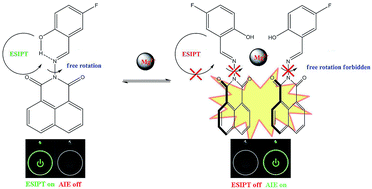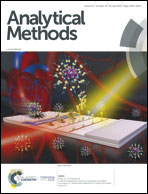New Schiff base chromophores composed of salicylaldehyde and naphthalimide derivatives for ion sensor applications†
Abstract
New Schiff base chromophores with salicylaldehyde and naphthalimide structures were synthesized and characterized using IR, 1H NMR, 13C NMR and HRMS. They all exhibited obvious solid-state fluorescence features because of their inherent twisted structures, and some of them showed high selectivity and sensitivity for Mg2+ detection due to the dual contributions of excited-state intramolecular proton transfer and an aggregation-induced emission effect. For these new Schiff base chromophores, it was found that adjusting the substituents with different electronic properties on the salicylaldehyde unit could fine-tune their range of emission wavelengths and photophysical properties. Also, changing the chain length based on the –N–N![[double bond, length as m-dash]](https://www.rsc.org/images/entities/char_e001.gif) C– structure could influence their response to metal ions. The research results provide valuable information and ideas on the molecular design of novel fluorescence materials and related specific applications.
C– structure could influence their response to metal ions. The research results provide valuable information and ideas on the molecular design of novel fluorescence materials and related specific applications.



 Please wait while we load your content...
Please wait while we load your content...